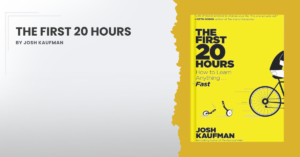Title: The Servant: A Simple Story About the True Essence of Leadership
Author: James C. Hunter
Year: 1998
Pages: 224
The Servant by James C. Hunter is a thought-provoking exploration of leadership, personal growth, and the power of service, creating the “servant leadership” concept.
This captivating book follows the journey of a successful (but arrogant) executive who discovers the true meaning of leadership through a series of profound experiences. As he learns to serve others, he transforms into a more effective and humble leader.
As a result, I gave this book a rating of 8.5/10.
For me, a book with a note 10 is one I consider reading again every year. Among the books I rank with 10, for example, is Dale Carnegie’s How to Win Friends and Influence People.
3 Reasons to read The Servant
Inspiration
The Servant inspires readers to adopt a leadership style centered on service and selflessness, challenging conventional notions of authority and control.
Personal Growth
Reading The Servant prompts introspection and self-reflection, inviting readers to examine their own values, motivations, and leadership practices.
Improved Team Dynamics
The principles of servant leadership can help create a more cohesive, collaborative, and productive team environment.
Book Overview
Servant leadership, as elucidated by Hunter in The Servant, is a paradigm where leaders prioritize serving others over self-interest.
The Servant follows John Daily, a seemingly successful businessman facing turmoil in his professional and personal life. Despite his outward appearance of success, John grapples with challenges at work, strained relationships, and a sense of obliviousness to his role in his own struggles. Encouraged by his pastor and wife, John reluctantly embarks on a week-long retreat at a monastery.
During his time at the monastery, John undergoes a profound transformation under the guidance of Simeon, a monk with a remarkable background in business leadership.
Alongside five other diverse individuals, John learns valuable lessons about leadership from Simeon. Through Simeon’s teachings, John gains insights that enable him to turn his life around and become the leader he was meant to be.
As John’s retreat comes to an end, and he reunites with his wife, there is a palpable sense that his experiences at the monastery have altered the course of his life forever.
Unlike traditional leadership models centred on authority and control, servant leadership emphasizes empathy, humility, and a deep commitment to the growth and well-being of others.
By embracing servant leadership principles, organizations can cultivate a culture of trust, collaboration, and innovation. Servant leaders inspire loyalty and commitment among team members, leading to enhanced productivity, morale, and ultimately, organizational success.
Critics argue that in certain contexts, a more assertive leadership style may be necessary to navigate complex challenges and drive results. However, Hunter’s message transcends prescriptive formulas, encouraging leaders to adapt their approach based on the needs of their team and the situation at hand.
One of the book’s greatest strengths is its ability to challenge conventional wisdom about leadership. By emphasizing the importance of service, Hunter encourages readers to reevaluate their approach to leadership and to prioritize the needs of others.
This shift in perspective can lead to profound personal and professional growth.
The Servant’s practical advice and real-life examples make it an invaluable resource for leaders seeking to improve their skills and effectiveness.
Hunter’s insights are grounded in his extensive experience as a leadership consultant, and his advice is both actionable and relevant.
The Servant is also notable for its emphasis on emotional intelligence and the importance of developing empathy, listening, and self-awareness.
These skills are essential for effective leadership, and Hunter’s guidance on how to develop them is both insightful and practical.
Overall, The Servant is a must-read for anyone seeking to become a more effective leader and to foster a more collaborative, productive, and fulfilling work environment. Its timeless wisdom and practical advice make it an invaluable resource for leaders at all stages of their journey.
What are the Key Ideas
Servant Leadership
The central theme of the book revolves around the concept of servant leadership, where leaders prioritize the needs of others over their own self-interest.
Purposeful Service
Hunter emphasizes the importance of serving with purpose, viewing leadership as a means of making a positive difference in the lives of others.
Empathy and Compassion
Central to servant leadership is the cultivation of empathy and compassion, fostering deep connections and understanding among team members.
Conceptualization
Servant leaders are visionaries who can conceptualize the future and inspire their teams to work towards a shared goal.
What are the Main Lessons
Lead by Example
The most effective way to lead is by example, embodying the principles of servant leadership in every aspect of your behavior and decision-making.
Servant’s Heart
Develop a genuine desire to serve others, and let this motivation guide your actions and decisions.
Practice Active Listening
Make a conscious effort to listen to others, and demonstrate that you value their perspectives and ideas.
Serve with Purpose
Align your leadership efforts with a higher purpose, focusing on creating value and making a positive impact in the lives of those you serve.
Build Trust
Trust is the foundation of effective leadership. Invest time and effort in building trust through transparency, consistency, and reliability.
Empower Others
Foster a culture of empowerment and autonomy, providing opportunities for others to take ownership of their work and contribute meaningfully to organizational goals.
My Book Highlights & Quotes
Listening is one of the most important skills a leader can choose to develop.
In The Servant, James Hunter delivers a timeless masterpiece that transcends the confines of traditional leadership literature.
Through compelling storytelling and profound wisdom, Hunter challenges us to reimagine leadership as a sacred trust, a noble endeavour guided by the principles of service, integrity, and compassion.
As we heed the call to servant leadership, we embark on a journey of transformation, one that has the power to uplift individuals, teams, and organizations, and ultimately, to create a more just and compassionate world.
I am incredibly grateful that you have taken the time to read this post.
Do you want to get new content in your Email?
Do you want to explore more?
Check my main categories of content below:
- Agile
- Blog
- Book Notes
- Career
- Leadership
- Management
- Managing Yourself
- Productivity
- Project Management
- Technology
- Weekly Pulse
Navigate between the many topics covered in this website:
Agile Art Artificial Intelligence Blockchain Books Business Business Tales Career Coaching Communication Creativity Culture Cybersecurity Design DevOps Economy Emotional Intelligence Feedback Flow Focus Gaming Goals GPT Habits Health History Innovation Kanban Leadership Lean Life Managament Management Mentorship Metaverse Metrics Mindset Minimalism Motivation Negotiation Networking Neuroscience NFT Ownership Parenting Planning PMBOK PMI Politics Productivity Products Project Management Projects Pulse Readings Routines Scrum Self-Improvement Self-Management Sleep Startups Strategy Team Building Technology Time Management Volunteering Work
Do you want to check previous Book Notes? Check these from the last couple of weeks:
- Book Notes #123: The Personal MBA by Josh Kaufman
- Book Notes #122: The First 20 Hours by Josh Kaufman
- Book Notes #121: A World Without Email by Cal Newport
- Book Notes #120: Storynomics by Robert McKee and Thomas Gerace
- Book Notes #119: Getting Things Done by David Allen
Support my work by sharing my content with your network using the sharing buttons below.
Want to show your support tangibly? A virtual coffee is a small but nice way to show your appreciation and give me the extra energy to keep crafting valuable content! Pay me a coffee:





